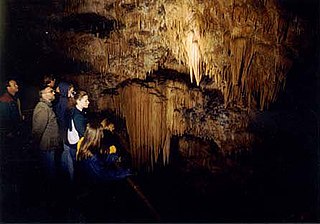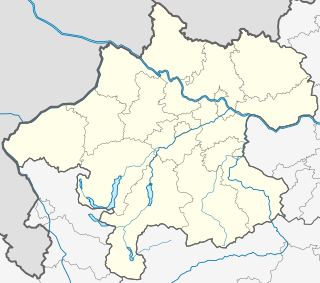Gassel Cave
| Gassel Cave
|
||
|---|---|---|
|
Guided tour in the Gassel stalactite cave |
||
| Location: | Erlakogel near Ebensee ( Salzkammergut ), Austria | |
| Height : | 1229 m above sea level A. | |
|
Geographic location: |
47 ° 49 '23 " N , 13 ° 50' 34" E | |
|
|
||
| Cadastral number: | 1618/3 | |
| Geology: | Main dolomite | |
| Type: | Dripstone cave , water cave , partial shaft cave | |
| Discovery: | 1918 | |
| Show cave since: | 1933 | |
| Lighting: | electric | |
| Overall length: | 4521 m | |
| Level difference: | 156 m | |
| Length of the show cave area: |
600 m | |
| Particularities: | Cave pearls with a diameter of 40 mm and a wealth of stalactites in the "sinter volcano hall" (outside the show area) | |
| Website: | www.gasselhoehle.at | |
The Gassel stalactite cave in a foothill of the Erlakogel near Ebensee ( Salzkammergut ) is a show cave in Upper Austria . Speleological publications describe the Gassel Cave as the cave with the most stalactite stones in the Northern Limestone Alps .
General
The under nature conservation standing cave is known especially nice to come for their rich limestone deposits, yellowish to dark brown ranging in color from pure white over and through the electric lighting advantage. The show cave can be visited as part of a 50-minute tour over a length of 250 m. The guide path is very well developed with stairs, platforms and concrete paths and can be walked safely in the company of a certified cave guide .
The show cave has been looked after by the Ebensee Cave Association since 1933 . This includes the front section, the rest of the cave system is only accessible for research. The cave and the area around the entrance are designated as a natural monument ( ND599 ).
location
The cave is located on the southern flank of the Gasselkogel ( 1411 m ), an extension of the Erlakogel in the eastern Traun Valley Pre-Alps. The only entrance known so far is at 1229 m above sea level.
A connection with the Gasselniedernhöhle is possible, one with the Rötelseehöhle seems rather improbable based on the state of the exploration.
Access
You can reach the cave on forest roads and well-developed hiking trails. The path leads from the village of Rindbach (municipality of Ebensee) past the Rindbach waterfall, which is a protected natural monument, and follows the lower Rindbachtal and Karbachtal through a wooded pre-Alpine landscape. The tour is also suitable as a full-day mountain hike with children. The walking time from Rindbach is about 2½ hours.
health
The temperature in the cave is between 6 ° and 7 ° C, the relative humidity is 100%. The cave air is practically germ-free under these conditions. The special therapeutic suitability against susceptibility to infection and bronchial asthma has already been confirmed by a health resort doctor.
Hiking destinations in the vicinity of the cave
A hike to the summit of the Gasselkogel, which can be reached in around 20 minutes from the Gassel cave , offers an excellent panoramic view of the Dead Mountains , Höllengebirge , Traunstein and Traunsee . In addition to direct access from Ebensee , there is the possibility of reaching the cave from other locations:
- from Offensee over the Farnau
- from the Jagersimmerl in the Almtal via the Grünangerl
- from Grünau over the Hintere Rinnbachtal and the Grünauer Boden
- as a descent to Karbach am Traunsee (from Karbach by water taxi back to Ebensee or via the Mairalm to Gmunden )
The last two hikes are not marked.
geology
The Gassel Cave is mostly located in the main dolomite , a rock in which caves are rather rare due to the fine fissure nature and bound to tectonic fault zones. Like the other dolomite karst areas in the Alps, the Gasselkogel is not fully karsted, and there are often above-ground channels. The majority of the duct profiles indicate a vadose formation; the typical phreatic duct profiles are rarely found in the cave. Disturbance surfaces and armor prove to determine the space, but are not visible due to heavy sintering and stalactite curtains. The structure of the cave is characterized by heavily sintered, spacious fissures and shafts that spread out like a labyrinth in the northern part of the cave. The plan view of the cave encounters difficulties with an overlay of up to five times.
Caving
discovery
The cave was discovered in 1918 and suddenly became known to the public. In 1931 it was declared a natural monument. The official opening as a show cave took place in 1933. In the parts of the cave near the entrance, numerous animal bones were found, including a complete skeleton of the cave bear, which is now extinct . The bones of brown bears , elk , lynx and deer were also found .
New research
The total length of the cave system is 4521 m, the greatest depth 156 m (as of November 2012). During new research between 1984 and 1989, the particularly stalactite-rich “New Part” was discovered. A special sensation was the discovery of the pearl hall. In addition to thousands of smaller cave pearls , a handful of "large" ones with a diameter of almost 40 mm were found. This makes them the largest cave pearls ever found in Austria.
In new research since 2007, extremely stalactite-rich cave parts were discovered in the so-called “Northern Territory” (including the “Sinter Volcano Hall”), but these cannot be shown during guided tours. In the "April Fool's Day" hall one encountered the largest stalactite column in the Gassel cave with a height of 11 m and a width of up to 6 m. In 2008 the very near-surface and heavily sintered "twin halls" east of the "April Fool's Day Hall" were explored for the first time.
gallery
Newly discovered, small siphon lake in the New Year's Eve Hall
The largest cave pearls found in Austria so far
literature
- Robert Bouchal, Josef Wirth: Cave Guide Austria - Over 100 caves with sketches, plans, access descriptions and 150 photos . Pichler Verlag, Vienna 2001, ISBN 3-85431-234-2 , pp. 128-130.
- Association f. Höhlenkunde Ebensee (Hrsg.): Höhlenforschung in Ebensee. Ebensee, 1989. 70 pp.
- Association of Austrian cave researchers (ed.): Files for the seminar show caves, cave protection and popular education. Ebensee, 1998. 96 pp.
- Peter Fink, Dietmar Kuffner, Johannes Mattes: Speleology in the Gassel stalactite cave. With photos and plans. In: Communications from the State Association for Speleology in Upper Austria. 55th year 2009/1, complete series 115, Linz, pp. 12-26.
- Peter Fink, Johannes Mattes, Emanuel Zeindlinger: Cave exploration in the Gassel stalactite cave (cat. No. 1618/3) - Association for caving in Ebensee. In: Communications of the State Association for Speleology in Upper Austria 54th year 2008/1, complete series 114, Linz, pp. 16-29.
- Dietmar Kuffner: New research in the Gassel stalactite cave (1618/3) near Ebensee. In: The cave. 59 / 1–4, Vienna 2008, pp. 103–110.
- Dietmar Kuffner: The Gassel stalactite cave, Ebensee. 1997.
- Dietmar Kuffner: 60 years of the Ebensee caving association. In: The cave. 44/2, Vienna 1993, p. 34 f.
- Dietmar Kuffner: The number of visitors to the Gassel stalactite cave (Upper Austria). In: The cave. 41/4, Vienna 1990, pp. 89-93.
- Dietmar Kuffner: 70 years of the Gassel stalactite cave (Upper Austria). In: Die Höhle 37/3, Vienna 1989, p. 65 f.
- Johannes Mattes: Research weekend in the Gassel stalactite cave (cat. No. 1618/3) of the Ebensee caving association. In: Communications from the State Association for Speleology in Upper Austria. 53rd year 2007/1, complete series 113, Linz, pp. 41–48.
- Johannes Mattes: About industrial workers, soldiers and cave tourists - research history and description of the Gassel stalactite cave near Ebensee (Upper Austria). In: Mitt. Verb. Dt. Höhlen- u. Karst explorers. 58 (2), Munich 2012, pp. 40-48 ( pdf , vdhk.de).
Web links
- Website of the show cave (gasselhoehle.at)
- Hiking trail to the cave and refuge , alpintouren.com
- Ground plan of the cave in scale 1: 1000 (PDF; 591 kB; gasselhoehle.at)
- Longitudinal section of the cave in scale 1: 2000 (PDF; 599 kB; gasselhoehle.at)
- 3D animation of the Gassel cave (surveying trains ) , gasselhoehle.at
- Video on caving in the Gassel cave , gasselhoehle.at
Individual evidence
- ↑ Dietmar Kuffner: New research in the Gassel stalactite cave (1618/3) near Ebensee. In: Die Höhle 2008. pp. 103–110. Here: p. 103.
- ^ A b Johannes Mattes : From industrial workers, soldiers and cave tourists - research history and description of the Gassel stalactite cave near Ebensee (Upper Austria) . In: Messages of the Association of German Cave and Karst Researchers eV Band 58 , no. 2 , June 4, 2012, ISSN 0505-2211 , p. 40–48 ( vdhk.de [PDF; 2.9 MB ; accessed on October 25, 2012]).
- ↑ Gasseltropfsteinhöhle, natural monument nd599 , State of Upper Austria, nature conservation database and nature conservation book> Geographical nature conservation information system (GENISYS)





